
The Defense Advanced Research Projects Agency (DARPA) is a research and development agency of the United States Department of Defense responsible for the development of emerging technologies for use by the military.

The telecommunications policy of the United States is a framework of law directed by government and the regulatory commissions, most notably the Federal Communications Commission (FCC). Two landmark acts prevail today, the Communications Act of 1934 and the Telecommunications Act of 1996. The latter was intended to revise the first act and specifically to foster competition in the telecommunications industry.

The Advanced Research Projects Agency Network (ARPANET) was the first wide-area packet-switched network with distributed control and one of the first computer networks to implement the TCP/IP protocol suite. Both technologies became the technical foundation of the Internet. The ARPANET was established by the Advanced Research Projects Agency (ARPA) of the United States Department of Defense.
The DARPA Grand Challenge is a prize competition for American autonomous vehicles, funded by the Defense Advanced Research Projects Agency, the most prominent research organization of the United States Department of Defense. Congress has authorized DARPA to award cash prizes to further DARPA's mission to sponsor revolutionary, high-payoff research that bridges the gap between fundamental discoveries and military use. The initial DARPA Grand Challenge in 2004 was created to spur the development of technologies needed to create the first fully autonomous ground vehicles capable of completing a substantial off-road course within a limited time. The third event, the DARPA Urban Challenge in 2007, extended the initial Challenge to autonomous operation in a mock urban environment. The 2012 DARPA Robotics Challenge, focused on autonomous emergency-maintenance robots, and new Challenges are still being conceived. The DARPA Subterranean Challenge was tasked with building robotic teams to autonomously map, navigate, and search subterranean environments. Such teams could be useful in exploring hazardous areas and in search and rescue.

A wireless mesh network (WMN) is a communications network made up of radio nodes organized in a mesh topology. It can also be a form of wireless ad hoc network.
Communication with submarines is a field within military communications that presents technical challenges and requires specialized technology. Because radio waves do not travel well through good electrical conductors like salt water, submerged submarines are cut off from radio communication with their command authorities at ordinary radio frequencies. Submarines can surface and raise an antenna above the sea level, or float a tethered buoy carrying an antenna, then use ordinary radio transmissions; however, this makes them vulnerable to detection by anti-submarine warfare forces.

Project 25 is a suite of standards for interoperable digital two-way radio products. P25 was developed by public safety professionals in North America and has gained acceptance for public safety, security, public service, and commercial applications worldwide. P25 radios are a direct replacement for analog UHF radios, but add the ability to transfer data as well as voice, allowing for more natural implementations of encryption and text messaging. P25 radios are commonly implemented by dispatch organizations, such as police, fire, ambulance and emergency rescue service, using vehicle-mounted radios combined with repeaters and handheld walkie-talkie use.
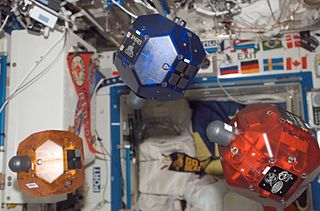
The Synchronized Position Hold Engage and Reorient Experimental Satellite (SPHERES) are a series of miniaturized satellites developed by MIT's Space Systems Laboratory for NASA and US Military, to be used as a low-risk, extensible test bed for the development of metrology, formation flight, rendezvous, docking and autonomy algorithms that are critical for future space missions that use distributed spacecraft architecture, such as Terrestrial Planet Finder and Orbital Express.
A wireless ad hoc network (WANET) or mobile ad hoc network (MANET) is a decentralized type of wireless network. The network is ad hoc because it does not rely on a pre-existing infrastructure, such as routers or wireless access points. Instead, each node participates in routing by forwarding data for other nodes. The determination of which nodes forward data is made dynamically on the basis of network connectivity and the routing algorithm in use.
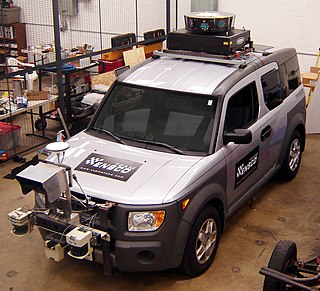
The third driverless car competition of the DARPA Grand Challenge was commonly known as the DARPA Urban Challenge. It took place on November 3, 2007 at the site of the now-closed George Air Force Base, in Victorville, California, in the West of the United States. Discovery's Science channel followed a few of the teams and covered the Urban Challenge in its RobocarsArchived 2008-07-30 at the Wayback Machine series.
The history of delay-tolerant networking examines the bulk of the technologies that began the field that is known today as delay-tolerant networking. Research began as projects under United States government grants relating to the necessity of networking technologies that can sustain the significant delays and packet corruption of space travel. Initially, these projects looked only short-range communication between manned missions to the moon and back, but the field quickly expanded into an entire sub-field of DTNs that created the technological advances to allow for the Interplanetary Internet.
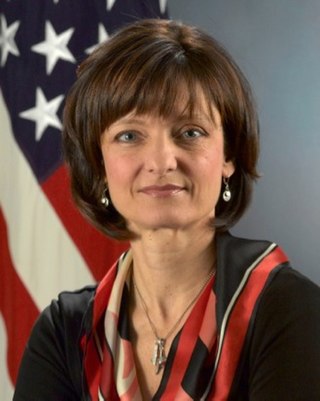
Regina E. Dugan, is an American businesswoman, inventor, technology developer and government official. She was the first female director of the Defense Advanced Research Projects Agency (DARPA), where she served from July 2009 until March 2012.

DARPA Shredder Challenge 2011 was a prize competition for exploring methods to reconstruct documents shredded by a variety of paper shredding techniques. The aim of the challenge was to "assess potential capabilities that could be used by the U.S. warfighters operating in war zones, but might also identify vulnerabilities to sensitive information that is protected by shredding practices throughout the U.S. national security community". The competition was sponsored by the Defense Advanced Research Projects Agency (DARPA), a research organization of the United States Department of Defense. Congress authorized DARPA to award cash prizes to further DARPA’s mission to sponsor revolutionary, high-payoff research that bridges the gap between fundamental discoveries and their use for national security.
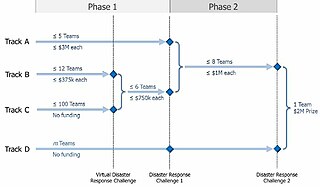
The DARPA Robotics Challenge (DRC) was a prize competition funded by the US Defense Advanced Research Projects Agency. Held from 2012 to 2015, it aimed to develop semi-autonomous ground robots that could do "complex tasks in dangerous, degraded, human-engineered environments." The DRC followed the DARPA Grand Challenge and DARPA Urban Challenge. It began in October 2012 and was to run for about 33 months with three competitions: a Virtual Robotics Challenge (VRC) that took place in June 2013; and two live hardware challenges, the DRC Trials in December 2013 and the DRC Finals in June 2015.

Chai Keong Toh is a Singaporean computer scientist, engineer, industry director, former VP/CTO and university professor. He is currently a Senior Fellow at the University of California Berkeley, USA. He was formerly Assistant Chief Executive of Infocomm Development Authority (IDA) Singapore. He has performed research on wireless ad hoc networks, mobile computing, Internet Protocols, and multimedia for over two decades. Toh's current research is focused on Internet-of-Things (IoT), architectures, platforms, and applications behind the development of smart cities.
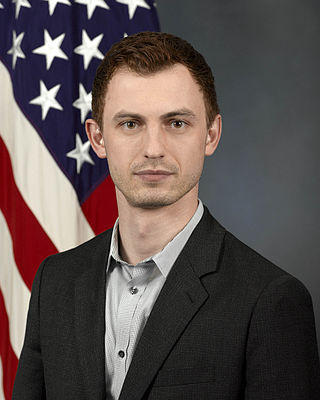
Paul Eremenko is a Ukrainian American innovator and technology executive. He was formerly the Chief Technology Officer and Senior Vice President of United Technologies Corporation. Earlier, he served as the CTO of Airbus, and former CEO of Airbus Silicon Valley innovation center. He is a former Google executive and head of Google's Project Ara, an effort to create an open, modular smartphone platform. Eremenko was named one of the Top-10 Tech Leaders of 2015 in FORTUNE Magazine. Eremenko has also come out as a strong proponent of artificial intelligence and autonomy research. Eremenko has cited his desire to build a starship as the motivation underpinning his career.
The 2016 Cyber Grand Challenge (CGC) was a challenge created by The Defense Advanced Research Projects Agency (DARPA) in order to develop automatic defense systems that can discover, prove, and correct software flaws in real-time.
Gazebo is an open-source 3D robotics simulator. As of 2023, it consists of two versions, known as "Gazebo Classic", the original monolithic version, and "Gazebo", a modernized collection of libraries. The latter was known for a time as "Ignition", but was renamed back to "Gazebo" in 2022.
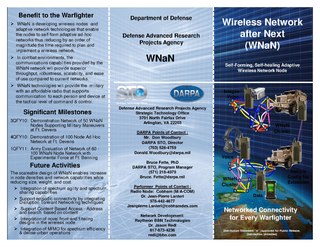
The Wireless Network after Next (WNaN) was a DARPA project to create and demonstrate an advanced tactical mobile ad-hoc network (MANET) that rapidly adapts to soldiers maneuvering in complicated environments, automatically determining the best radio frequencies and network paths to maximize connectivity and throughput. In 2010 it was successfully demonstrated in live military experiments containing up to 100 nodes, the largest military MANET demonstrated to that date.
Over the years, the U.S. Defense Advanced Research Projects Agency (DARPA) has conducted a number of prize competitions to spur innovations. A prize competition allows DARPA to establish an ambitious goal, which makes way for novel approaches from the public that might otherwise appear too risky to undertake by experts in a particular discipline.












